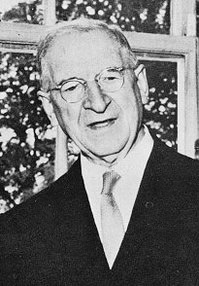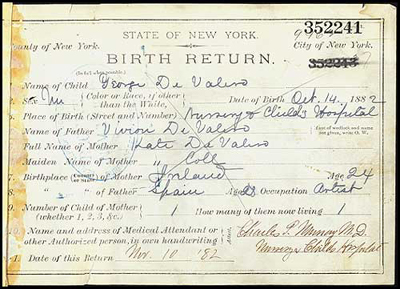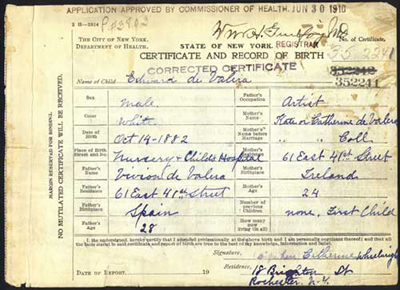Irish
Historical Mysteries: Eamon de Valera's
Father Vivion Juan de Valera

Eamon de Valera (1882-1975)
Resumen en
español: El político irlandés Eamon de
Valera nació en Nueva York en 1882, siendo sus padres Vivion
Juan de Valera y Catherine Coll. Se dice que Vivion Juan era
español o cubano, pero a pesar de intensas investigaciones no se
ha encontrado ninguna evidencia que lo demuestre. Se cree que Vivion
Juan murió en Nuevo México hacia 1885 y en el siguiente
artículo se plantea la pregunta de si pudiera haber sido natural
de dicho estado.
In the years since the
death of the Irish statesman Eamon
de Valera,
and even during his
lifetime, there has been considerable mystery concerning his paternal
ancestry. It is known that de Valera was born in New York on 14 October
1882, the son of Vivion de Valera or Valero and Catherine or Kate
Coll. De Valera fought in the Irish War of Independence but
famously split with Michael Collins on the issue of the Treaty
compromise with the British in 1921. De Valera inspired extremes of
devotion and
loathing, and his political opponents spread stories to the effect that
he was illegitimate. (1) Starting with the basic documentation, it can
be seen that there are two
versions of de Valera's birth certificate, the first giving his name as
George
and his father's surname as de Valero, the second corrected version
issued in 1910 (not 1916 as has been claimed) at the request of his
mother, with the forename recorded as Edward (of which Eamon is the
Gaelic form) and
the family surname spelt de Valera. (2)
Both certificates indicate that Vivion was born in Spain about 1854,
and
that Catherine was born in Ireland about 1858. While Catherine's place
of origin, near Bruree, County Limerick, is well documented, persistent
efforts have so far failed to confirm Vivion's country of birth.
Original and corrected birth
certificates of Eamon de Valera
(images courtesy of New York City Department of Records)
De Valera's official biography
states that his father Vivion Juan (an added second name) was born in
Spain, that the latter's father Juan 'was engaged in the sugar
trade between Cuba and Spain and the United States', and that his
mother Amelia Acosta 'had died when he was young'. Vivion Juan and
Catherine Coll are said to have been married in Greenville, New Jersey,
on 19 September 1881. The official biography further states that Vivion
Juan worked as a music teacher, but as a result of illness left New
York for the
healthier air of Denver, Colorado, dying there or on the way in 1885.
(3) Intensive efforts, particularly by de Valera's biographer Tim Pat
Coogan and the genealogist Joseph M Silinonte,
have failed to locate any marriage record, nor has a death record or
indeed any further significant documentation relating to Vivion Juan
been forthcoming. (4) Disappointingly, a major reassessment of de
Valera published under the auspices of the Royal Irish Academy failed
to deal with the problematic issue of its subject's paternity, indeed apparently ignoring Vivion de Valera altogether. (5)
A memoir by the late Terry de Valera, Eamon de
Valera’s son, contains what is claimed to be a definitive account of
the Hispanic origins of the family. (6) It is claimed that a
connection has been established with the Valera family of Spain, and
cousinship proven with the Marqués de Auñon. In this account it
is stated that de Valera’s father Vivion Juan was a grandson of Antonio
Valera of Seville in Spain, brother of the author and diplomat Juan
Valera. It is claimed that the family had interests in Cuba, and it was
from there that Vivion Juan moved to the United States, marrying Kate
Coll. Unfortunately, no documentation is cited to verify the connection
with the Spanish Valeras, and the tale appears to be a largely
imaginative development of de Valera’s own unsuccessful attempt to
establish a link (of which more below). At one point Terry de Valera
concedes that the name Vivion ‘does not appear to have been used’ by
the Spanish Valeras. (7) The author angrily rejects the charge that
Eamon de Valera’s parents may not have married, clearly responding to
an implication in Coogan’s biography but without naming the author.
(8) Unfortunately, it remains a fact that no trace can be found of a marriage record of Vivion de Valera and Kate
Coll, and in our hopefully more understanding times, there need be no
problem considering the probability that their son Edward or
Eamon was born out of wedlock.
Eamon de Valera's suggested Cuban
connection was in the news in recent years, with a claim by Professor
Brendan Ward of Columbia University in New York that he has tracked
down his father's baptism, communion and confirmation certificates in
Mantanza. (9) A television documentary was reportedly planned, and the present
writer would certainly be interested in examining any new evidence
found. The late Proinsias Mac Aonghusa also claimed that he had
confirmed a Cuban origin for Vivion Juan, stating that he had been
born
there in 1853 and that his father Juan Manuel owned a sugar cane estate
in Matanzas Province, but unfortunately documentation to confirm this
story is again wanting. (10) A Cuban connection is certainly a
possibility, and it should be borne in mind that the expression
'Spanish' could apply
to those born in existing or former Hispanic colonies.
The extensive papers of Eamon de
Valera are now held in the Archives Department of University College
Dublin at Belfield, and the present writer has spent some time
examining them for information which would throw light on the matter of
the statesman's paternal ancestry. (11) The substantial quantity of
material in his papers relating to
his ancestry, and particularly his paternal ancestry, shows that the
matter was of considerable importance and indeed sensitivity to de
Valera. It is clear that de Valera's mother was the prime source of the
information transmitted about his father Vivion Juan. De Valera had
been sent back to Ireland as a child to be reared by his Coll
relatives, while his mother remained in the United States and
remarried. In adulthood de Valera maintained contact with his mother,
and the subject of his father came up in
correspondence from time to time. Thus while in prison in Dartmoor in
the wake of the
1916 Rising, de Valera put several questions to his mother concerning
his father and a possible connection with certain prominent
Spanish
families bearing the surname, concluding rather wistfully, 'My own
children will be asking these questions shortly I expect'. (12)
Throughout his years as Irish
prime minister in the 1930s and even after his election as President of
Ireland in 1959, de Valera maintained the quest for information on his
elusive father. The usual pattern was that de Valera would initiate
discreet enquiries, or respond to suggested leads, following which
efforts to document Vivion Juan would be made. De Valera was
sensitive to any publicity concerning his paternal quest, expressing
regret that an apparently indiscreet contact in Philadelphia had been
the cause of the story appearing in the press. (13) It is clear that
despite the efforts of many sympathetic helpers working in the United
States and Spain, nothing conclusive was ever found. A possible link to
the family of the Spanish novelist and diplomat, Juan Valera, which
family had Cuban connections, was explored by the Irish Ambassador to
Spain, Leopold H Kerney in 1936. Kerney interviewed the Marqués
de Auñon, grandson of Juan Valera, who claimed that a brother of
his grandfather had married an Irish girl in New York. Unfortunately,
there was no recollection of anyone bearing the distinctive forename
Vivion, and both Kerney and de Valera feared that the story could be
'of recent growth'. (14)
After de Valera's election as President, he did not
as might have been expected secure a grant of a coat of arms from the
Office of the Chief Herald of Ireland. Advancing only his family
tradition of a Spanish connection, de Valera in 1965 managed via
the Cronista Marqués de Ciadoncha to secure usage of existing arms in the
form of a shield quartered with
lions rampant and stylised
crescent moons, and a bordure of x-shaped crosses, which arms were
compliantly certified by the serving Chief Herald Gerard Slevin in
1966. (15) It is important
to emphasise that use of these arms is not proof of a connection
between de
Valera and a specific armigerous Spanish family, but is merely based on
an assumption that such a link existed. De Valera's failure to secure arms from the Irish Chief Herald is ironic in light of
the fact that he had facilitated the establishment of
an indigenous heraldic authority to replace the British regime's Ulster's Office in 1943. Other Irish
Presidents, and indeed two United States Presidents have been issued with arms by Chief Heralds over the years,
although it emerged in the wake of the Mac Carthy Mór scandal in 1999 that the office had no adequate legal
authority to grant arms. (16)
As late as 1962, de Valera made
another attempt to trace a marriage record for his father and mother in
St Patrick's Church, Jersey City, in 1881. The priest replied in the
negative, suggesting diplomatically that there may have been 'neglect
of entry', but that after such a long lapse of time the task of
ascertaining the fact of marriage seemed 'well nigh impossible'. (17)
In 1963-64, de Valera's cousin Edward P Coll
was making systematic enquiries as to Vivion Juan's fate in the United
States. Coll was based in the
De Vargas Hotel, Santa Fé, New Mexico, where he seems to have
been employed, and from thence sent out
numerous requests to priests and civil registrars to search for a
burial record. Coll's form letter specified that Vivian Juan de Valera
had set out for Santa Fé in 1883 when suffering from
tuberculosis, and that a report reached the family in 1885 that he had
died and was buried in New Mexico. Coll received no positive replies to
his many letters. (18) However, it would seem that some
additional information may have been received by the de Valera family
to
shift the focus of Vivion Juan's last days from Colorado to the
adjoining state of New Mexico. And as we shall now see, New Mexico
had also come to my attention via other sources.
Even before tackling the de Valera Papers, I had
been using the growing body of genealogical records available on the
Internet in an effort to solve the mystery of Eamon de Valera's
paternal ancestry. The Church of Jesus Christ of
Latter-Day Saints (Mormon) website is the world's largest free online
genealogical database, providing an invaluable resource for studying
surname distribution in the western world and many former colonial
possessions. (19)
It seemed appropriate to start by listing the locations in the which
were found the surname forms de Valera and de Valero, excluding other
variants for the time being. The specific surname forms de Valera and
de Valero were not found to be very common, and in addition to Spain,
they occurred in Mexico, Cuba, Barbados, Peru, and Venezuela. The
forms Valera and Valero, without the prefix 'de', were found
to be much more common, and while again concentrated in the Hispanic
world, in Spain, Central and South America, the Caribbean and the
Phillipines, there were some occurrences also in Germany, the
Netherlands and even Britain.
A second approach was to study
the distribution of the surname de Valera and variants within the
borders of the United States of America as recorded in the 1880 Census,
which was most efficiently done via the subscription website of the
firm Ancestry. (20) It was established that there were no occurrences
of
the forms de Valera and de Valero in the 1880 Census. Dropping the prefix,
the
following results were obtained:
Valera
12 entries (8 Pennsylvania, 2 New Mexico, 1 New York, 1 Texas)
Valero 7 entries (6 New Mexico, 1 Texas)
The
Pennsylvanian entries were clearly of German origin, while the single
New York entry related to a Claudis, recte Claudio Valera, who was born
in Cuba about 1856, and was listed as a student resident in Queens
Borough. The latter individual should certainly be borne in mind given
the claimed Cuban connection of Eamon de Valera's father. (21) However,
the significant New Mexico cluster attracts particular attention,
given the above mentioned reference discovered in the de Valera Papers.
Employing the Soundex option, whereby similarly
spelt and sounding entries are returned, the
following results were also noted in Ancestry's 1880 Census index:
Valerio
59 entries (47 New Mexico, 11 Colorado, 1 California)
Valeria 10 entries (7 New Mexico, 1 Iowa, 1 Kentucky, 1 New York)
It should be
noted that the surname forms Valerio, Valeria and Valero are also
Italian, while
Valero has a small but significant German distribution, but again the
New Mexico concentrations stand out.
Turning to the relatively rare
forename Vivian, it was found that in general in 1880
there was either a preponderance of use in favour of females or else a
rough equality, for
example:
Pennsylvania
12 males and 21 females
New York 18 males and 18 females.
However, in the
south-western states referred to above there was a preponderance of
males
called Vivian in 1880:
New
Mexico 41 males and 2 females
Texas 33 males and 22 females
Colorado 8 males and 3 females
Most of the Texas
Vivian entries feature non-Hispanic surnames, and while most of
the Colorado entries feature Hispanic surnames, 4 of the individuals
concerned are described
as having been born in New Mexico. The name derives from St Vivian, a
fifth-century French
bishop, the usual female forms being Vivien or Vivienne (Oxford
Dictionary of First Names).
Vivion spelt with an 'o', the form preferred by the de Valeras in
Ireland, is relatively
uncommon in the 1880 United States Census and is not found at all in
New Mexico.
Hispanics sometimes use the form Bibian(o) in place of Vivian(o),
reflecting the pronunciation of
the letter 'v' in Spanish, with the female forms being respectively
Viviana and Bibiana.
At this stage we can observe that
both in terms of the concentration of the surname Valera and its
variants and the use of the forename Vivian for males, New Mexico
features
very prominently. However, it should be noted that no example was found
of the use of the two names in conjunction in records relating to this
state. We
can also recollect the element of the de Valera family story which has
Vivion Juan making a final journey in the direction of Colorado and New
Mexico. This gives
further reason for at least
considering the possibility that one of these two states could in fact
have been the point of
origin of Eamon de Valera's father, with New Mexico again being the one
most strongly
flagged. Might not the ailing Vivion Juan de Valera's final journey
have been that of a man returning to his birthplace? Of course New
Mexico is the most Hispanic part of the United States, and Mexico
proper south of the border must be kept in the reckoning, while Spain
and Cuba as we have seen remain in play. In conclusion, it should be
stressed therefore that the New Mexico connection for Eamon de Valera's
family which has been advanced in this piece remains a hypothesis
requiring much further research to confirm or refute, which research is
ongoing, and will be reported here from time to time.
Sean J Murphy
7 December 2005, last amended 21 July 2008
References
(1) Tim Pat Coogan, De Valera: Long Fellow, Long Shadow,
London 1993, pages 5-10.
(2) 'Notable New Yorkers: Eamon de Valera',
http://www.nyc.gov/html/records/html/features/devalera.shtml,
accessed
7 December 2005, revised version noted 18 July 2008.
(3) The Earl of Longford and T P O'Neill, Eamon de Valera, London 1970, pages
1-2.
(4) Coogan, De Valera, pages 8-9; Joseph M Silinonte, articles in Irish Roots,
1999-2004.
(5) Diarmaid Ferriter, Judging Dev: A Reassessment of the Life and Legacy of Eamon de Valera, Dublin 2007; references to Vivion de Valera in the index to this work all appear to refer to Eamon de Valera's son.
(6) Terry de Valera, A Memoir,
Dublin 2005, pages 157-65; references to Vivion de Valera in the index
to this work all appear to refer to Eamon de Valera's son.
(7) Same, page 159.
(8) Same, pages 167-70.
(9) Ireland On-Line, 20 November 2005,
http://breakingnews.iol.ie/news/story.asp?j=163160130&p=y63y6x836.
(10) Letter to Irish Times, 8
June 1999, and a letter to the author 20 February 2002, in which Mac
Aonghusa stated that much of what had been written about de Valera's
father is 'fiction'.
(11) De Valera Papers, Archives Department, University College Dublin, P 150,
microfilm copies. The writer acknowledges permission of the UCD-OFM
Partnership to
cite the De Valera Papers. Access to the papers is by appointment, and
for further details see http://www.ucd.ie/archives.
(12) De Valera to Mrs Catherine Wheelwright, 18 September 1916, UCD Archives P
150/172.
(13) Same to Rev Thomas J Wheelwright, 5 January 1944, UCD Archives P 150/200.
(14) Correspondence of Leopold H Kerney, Irish Ambassador to Spain, and
enclosures, 1936, UCD Archives P 150/224.
(15) Correspondence concerning de Valera coat of arms, 1959-65, UCD Archives P
150/226.
(16) Sean J Murphy, 'An Irish Arms Crisis', http://homepage.eircom.net/%7Eseanjmurphy/chiefs/armscrisis.htm.
(17) De Valera to Rev James A Hamilton,
19 December 1962, and Rev Hamilton's reply 8 January 1963, UCD Archives P 150/227.
(18) Letters of Edward P Coll, Santa
Fé, 1953-64, UCD Archives P 150/216.
(19) FamilySearch,
http://www.familysearch.org/, search facility, accessed 7 December 2005.
(20) Ancestry, http://www.ancestry.com/,
1880 Census, accessed 7 December 2005.
(21) The Ancestry site shows that Claudio
Valera was listed as an institutionalised patient in the 1900 Census,
and that he died in New York in 1902.
Back
to Irish Historical Mysteries: Contents



